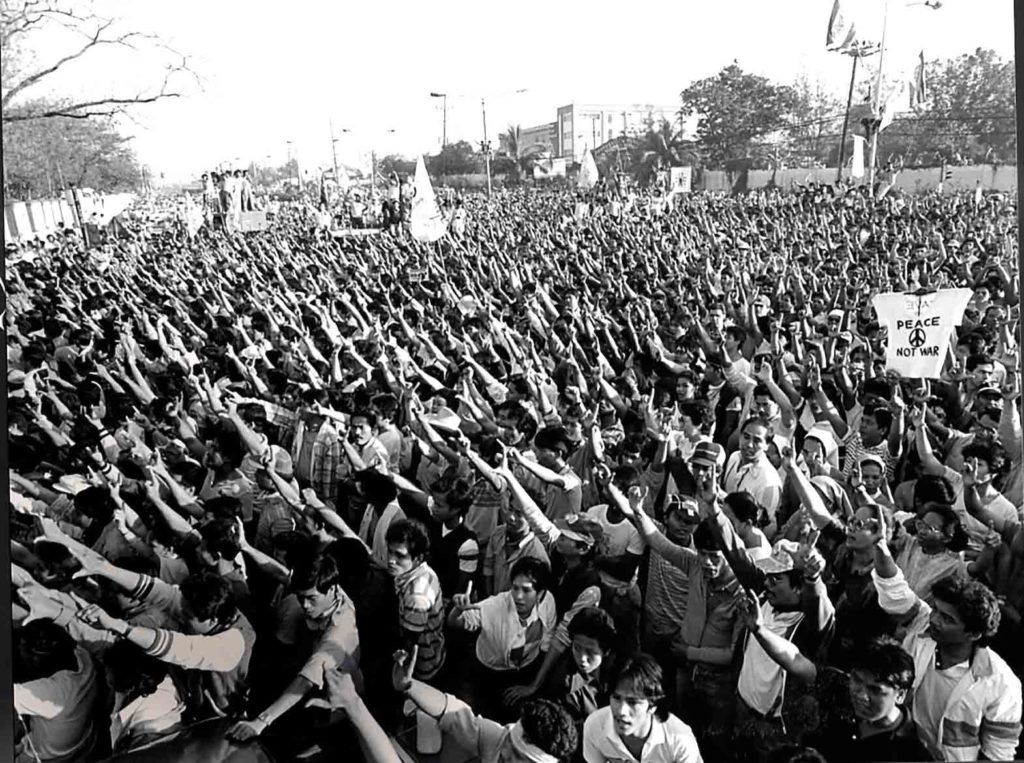
EDSA People Power Revolution, 1986: What went wrong? Why has a nation returned to power the same family that it booted out in 1986 with little to no bloodshed? FILE PHOTO
NEW YORK—This week marks the 37th anniversary of the 1986 People Power uprising. There will be commemorations and celebrations as well, but the latter will likely be muted for the simple reason that as a nation we seem to have gone backwards.
The promise of 1986 remains inchoate. The current regime has absolutely no interest in recalling those four glorious and feverish days in February when an irate citizenry booted out a despot and his family, too long in power, too long in greedily feeding off the trough of the nation’s treasury, too long in subverting and corrupting the democratic foundations—thin, to begin with—of society, too long in imposing a perverted sense of national unity, dressed in the sheep’s clothing of a new society.
What went wrong? Why has a nation returned to power the same family that it booted out in 1986 with little to no bloodshed?
Many reasons have been advanced and all of them good.
Historical amnesia, that which makes those ignorant of history repeat it. We have and keep doing so.
Massive disinformation. The savvy and well-funded use of social media platforms to spread false counternarratives.
Miseducation, with public school textbooks having scant information, much less analysis, of the causes and the subsequent, deep and traumatizing wounds inflicted on the body politic by martial law and the Marcoses and their cronies.
Hence, to the younger generation that never experienced life under a brutal dictatorship, the Marcos era was an unrivalled “golden age.”
While all these reasons give us necessary details pertinent to 1986 and its aftermath, they fail to render a complete portrait.
That can be had by stepping back and examining 1986 in the light of the 1896 revolution against Imperial Spain, spearheaded by the KKK, or the Kataastasan Kagalagalangan Katipunan ng Mga Anak ng Bayan (The Highest and Most Honorable Society of the Nation’s Sons and Daughters). Led by Andres Bonifacio, the working-class firebrand, the movement was riven by internecine conflicts, resulting in Bonifacio’s assassination and Emilio Aguinaldo emerging triumphant as the head of the revolution.
However, the truce of Biak-na-Bato in 1897, inexplicably agreed to by Aguinaldo, halted the revolutionary momentum that would have resulted in Spain’s defeat. Why Aguinaldo would agree to a temporary cessation of hostilities and even leave Manila for Hong Kong seems incomprehensible unless the sum of $400,000 offered by the Spanish to the provisional government be seen as a bribe. In short, Aguinaldo snatched defeat from the jaws of victory.
The ensuing delay in bringing the Spanish occupation to an end results in the Philippines being caught up in the 1898 Spanish-American War, with Spain being defeated and Las Islas Filipinas being taken over by the United States for $20 million, or a little less than $3 per head of the 7 million population.
In the interim period of about five months between the end of that war and the start of the 1899 Philippine-American War, when the Philippine revolutionary army vastly outnumbered the US troops at that time and could have forced the bluecoats to withdraw, the vested interests heavily represented in Aguinaldo’s Cabinet argued against taking the initiative and instead accepting US offers of a measure of autonomy and much needed reforms under their tutelage. That meant that the system under which the elites who had prospered under the Spanish would continue uninterrupted. Aguinaldo himself came from a well-to-do family and so his instincts were more reformist rather than revolutionary. The two revolutionaries who might have moved the government to confront the United States right away were no longer around, having been assassinated: Bonifacio in 1897 and later, in 1899, with the Philippine-American War having broken out, the hawkish General Antonio Luna.
Was Emilio Aguinaldo behind these killings? Perhaps. What is indisputable is that Bonifacio and Luna who led the struggle to establish a truly independent and democratic republic were the victims of well-entrenched families whose fortunes were entwined with the very system that oppressed the vast majority of their countrymen.
The so-called revolution of 1986 was meant to finish what had been started in 1896. However, the same elements that vitiated the revolutionary spirit then made sure that the same acts of betrayal would once again be carried out.
Not only were the Marcoses allowed to return, their patriarch, the tyrant Ferdinand, is now entombed in the National Heroes Cemetery. A murderer, now a martyr. (Interestingly, there are plans under the current dispensation to make a film on the assassination of Ninoy Aquino, Marcos’s main rival, to be titled, Martyr or Murderer?)
Not a single Marcos crony has ever stood trial.
Under former president Rodrigo Duterte, authoritarianism was revived and is now alive and well.
The political arena continues to be monopolized by a few familial dynasties, most paying lip service to democracy but in reality busily reducing the little democratic space left.
Ninety-eighty-six was supposed to be a vindication of 1896. Instead, it is simply déjà vu, a heady dream of freedom turning into a recurring nightmare.
Copyright L.H. Francia 2023

